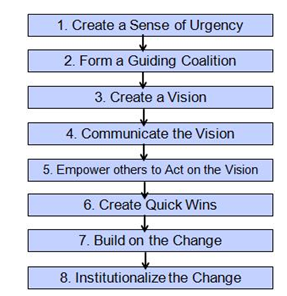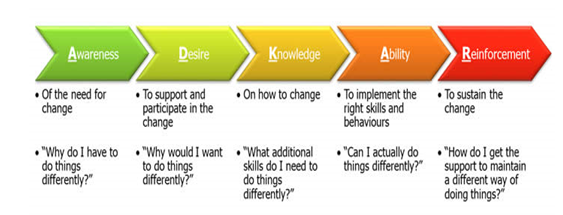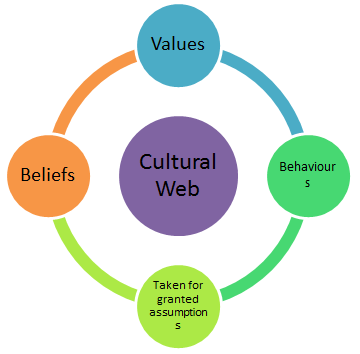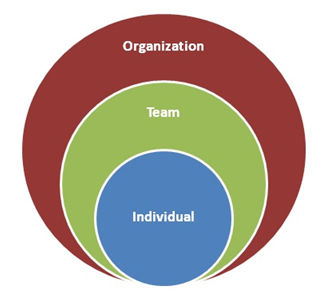Change management is the term used to transform people, individual, projects, groups and organizations from one state to the other. When this system is implemented to the projects and business, it is considered as the process of changing the opportunities of the business in such a way that every changing objective could be achieved. The paper includes cultural web approach and knowledge management. Change management includes the execution of structured process and a pre-planned approach for steering business from its recent condition to the desired situation.
Change management theories help a business to raise the scopes of the business staying on its path which afterwards leads to advantages. In this paper, the researcher will discuss various change management theories model like Kotter’s model, Lewin’s model, ADKAR model approach that can be used in the business for meeting needs. The study will include the comparison between two important theory models like Kotter’s model and Lewin’s model. Apart from this, the paper will also include cultural web approach and knowledge management with the help of suitable examples. At last, the study will also conclude current change theories with the help of recommendations that can be used in the business to get advantages.
Change management includes the execution of structured process and a pre-planned approach for steering business from its recent condition to the desired situation. Change management theories help businesses to raise the scopes of its staying on the path which afterwards leads to advantages. In the following, different models of the change management theory are demonstrated:
Lewin’s model of change management is the most effective model which understand the whole organizational structure and cultural change (Call for Papers:Journal of Change Management, 2015). This model was designed by Kurt Lewin in the year 1950; it is the oldest model but is still the most effective model for execution. The model has three primer stages such as unfreeze, change and refreeze.
Lewin change management approach is appropriately acquired by Tesla Motors. For Tesla change is required to assist the company to adjust appropriately with other dominant players in the automobile industry. The first step indicates the notification to be done to employees about the new ways of working. The second step would involve the helping the staffs to resolve any queries and worries about embracing the new methods of working. The final step of Tesla would be the internalizing the changes and to make them permanent.

Figure 1: Lewin’s Change Model (Czichos, 2014)
Kotter’s theory of change management is one of the popular models that have been executed once by almost everyone in the world. This theory has been designed by John P. Kotter, who is an author of various change management books and is also a Harvard Business Scholl Professor (Czichos, 2014). Kotter divides its changes management model into eight stages where every stage concentrates on the main aspect which is aligned with the feedbacks of people to change.
Enhance Urgency- This stage includes making a sense of urgency among the people for motivating them in order to move ahead towards their goals and objectives (Czichos, 2014.

Figure 2: Kotter’s Change Model (Czichos, 2014)
ADKAR model of change management is objective- oriented model that creates it possible for different change management groups for focusing on the activities which are directly associated with the objectives that it wants to achieve (Have, 2017). The objective and outcomes which come from this model are in a series and cumulative. It means that at the time of utilizing this model, people should get every outcome in a particular series fashions for the reason, change can execute and sustained.
Awareness- of the necessity and need for change
Desire- to create changes and participates in it
Knowledge- of how to create changes
Ability- to integrate the change constantly
Reinforcement- to hold it executed and armoured on afterwards
To give support and guidance to workers to carry on with the change process at the time of change management is happening (Have, 2017).

Figure 3: ADKAR Change Model (Czichos, 2014)
The cultural web is a model which is used to represent the connection between the assumptions taken for granted, structures, symbols and behaviours which categorize organizational culture (Lindberg, 2013). This model is mainly used by the managers of an enterprise as ways of understanding organizational culture. This model includes four layers such as:
Values- Easy to analyse in an enterprise because they tend to be written as rudiments regarding the company’s objectives(Lindberg, 2013)
Beliefs- These layers are much specific but are evident from business statements.
Behaviours- These are the constant way under which the company operates and also contains schedule and structure (Lindberg, 2013).
Taken for granted assumptions- These are the core of the company’s culture. They are also complicated for analysing and identifying. They are also considered as the organizational paradigm, where paradigm is the group of assumptions that are in taken for granted.

Figure 4: Four layers of Cultural Web (Have, 2017)
Knowledge Management is basically a conception for analysing, sharing, innovating, reusing and capturing through efficiently using organizational experiences. Companies commenced that knowledge management is becoming the main aspect in entire strategies for staying competitive and enterprises are trying to execute knowledge management with combined outcomes (Murthy, 2007). Knowledge is basically apprehended by individuals and those individuals’ forms organizations. For the enterprise to change individuals who are related to the enterprise, the concentration should be on the demand for behavioural change. Organizations and individuals have absorbed the idea of “Knowledge is power”, as the more individual reserves make them the most valuable people in the company (Parsells, 2013). This idea requires to be changed to “Knowledge sharing is power” because the more they share others can respond and together as an organization.

Figure 5: Knowledge Management Concept (Have, 2017)
Kotter’s eight stages model has advantages and drawbacks also. The advantage of Kotter’s eight stages model is that, it is a step-by-step model. It does not concentrate on change itself instead the acceptance of this change makes it smooth transitions. It also concentrates on the purchase-in of workers because of the main focus for achievements (Reiss, 2012). It may be communicated between all stages and implements in traditional hierarchy as well. The only drawback of this model is that, if one of any stages is being ignored or failed then the entire stages of changes method completely fails.
Whereas, Lewin’sthree steps model still takes time with it too, three steps model of Lewin is quite useful to understand the changes in stable situation as well as the vibrant changes in now a day world of businesses (Special issue on Barriers to innovation and organizational change: theories, methods, practices, 2013). But a drawback of this, it has been seen that Lewin’s model has observed changes of behaviour as a method from top to bottom and it can be exactly to state that analysed that may be started the low, medium or high, but it cannot be successful without the active contribution.
From the above study, it has been analysed that Change management theories help the business to raise the scopes of a business staying on its path which afterwards leads to advantages. Communication with every people about the changes and its objectives is quite a significant portion of the Kotter’s change management theory model. Lewin’s model of change Management is the most effective and famous model which makes to understand the whole organizational structure and cultural change. It has been found that knowledge is basically apprehended by individuals and those individuals’ forms organizations. For the enterprise to change individuals who are related to the enterprise, the concentration should be on the demand for behavioural change.
It is evident that changes made in organisations are mainly due to two factors, namely, change that is imposed due to circumstances and the change which is made to encourage growth. A change management system is designed to help the business to change instead of reacting to it. It is important for the companies to cooperate to the changing business context and thus have to implement change. In order to implement change management process appropriately, organisations first must understand what needs to be improved. As most of the changes are made to improve a process, it is very important to identify the reason to change. Recognition of the resources and the individuals which facilitate the change procedures and lead to encouragement must also be done. Another thing that companies could do while implementing change is determining its organisational eagerness. There are some tools and paradigms that can evaluate how ready organisation is to have change or the organisation need a change process or not. Improving the communications is also very crucial in the change process. Having a poor communication could create a deep impact on the successful implementation of change management. Bulletin boards, corporate newsletters, cafeteria postings are some of the communications tactics that could be used by managers of the organisations to communicate properly with its employees regarding the organisational change.
Call for Papers:Journal of Change Management. (2015). Journal of Change Management, 15(4), pp.353-355.
Czichos, R. (2014). Change Management. Freiburg imBreisgau: Haufe-Lexware.
Have, S. (2017). Reconsidering change management. New York: Routledge.
Lindberg, D. (2013). Change Management Tools for Systemic Results. Change Management: An International Journal, 12(3), pp.1-6.
Murthy, C. (2007). Change management. Mumbai [India]: Himalaya Pub. House Pvt. Ltd.
Parsells, R. (2013). Change and Learning in the Workplace. Change Management: An International Journal, 12(1), pp.61-71.
Reiss, M. (2012). Change management. [Place of publication not identified]: Books On Demand Gmbh.
Special issue on Barriers to innovation and organizational change: theories, methods, practices. (2013). Journal of Organizational Change Management, 26(6).
Delivering a high-quality product at a reasonable price is not enough anymore.
That’s why we have developed 5 beneficial guarantees that will make your experience with our service enjoyable, easy, and safe.
You have to be 100% sure of the quality of your product to give a money-back guarantee. This describes us perfectly. Make sure that this guarantee is totally transparent.
Read moreEach paper is composed from scratch, according to your instructions. It is then checked by our plagiarism-detection software. There is no gap where plagiarism could squeeze in.
Read moreThanks to our free revisions, there is no way for you to be unsatisfied. We will work on your paper until you are completely happy with the result.
Read moreYour email is safe, as we store it according to international data protection rules. Your bank details are secure, as we use only reliable payment systems.
Read moreBy sending us your money, you buy the service we provide. Check out our terms and conditions if you prefer business talks to be laid out in official language.
Read more